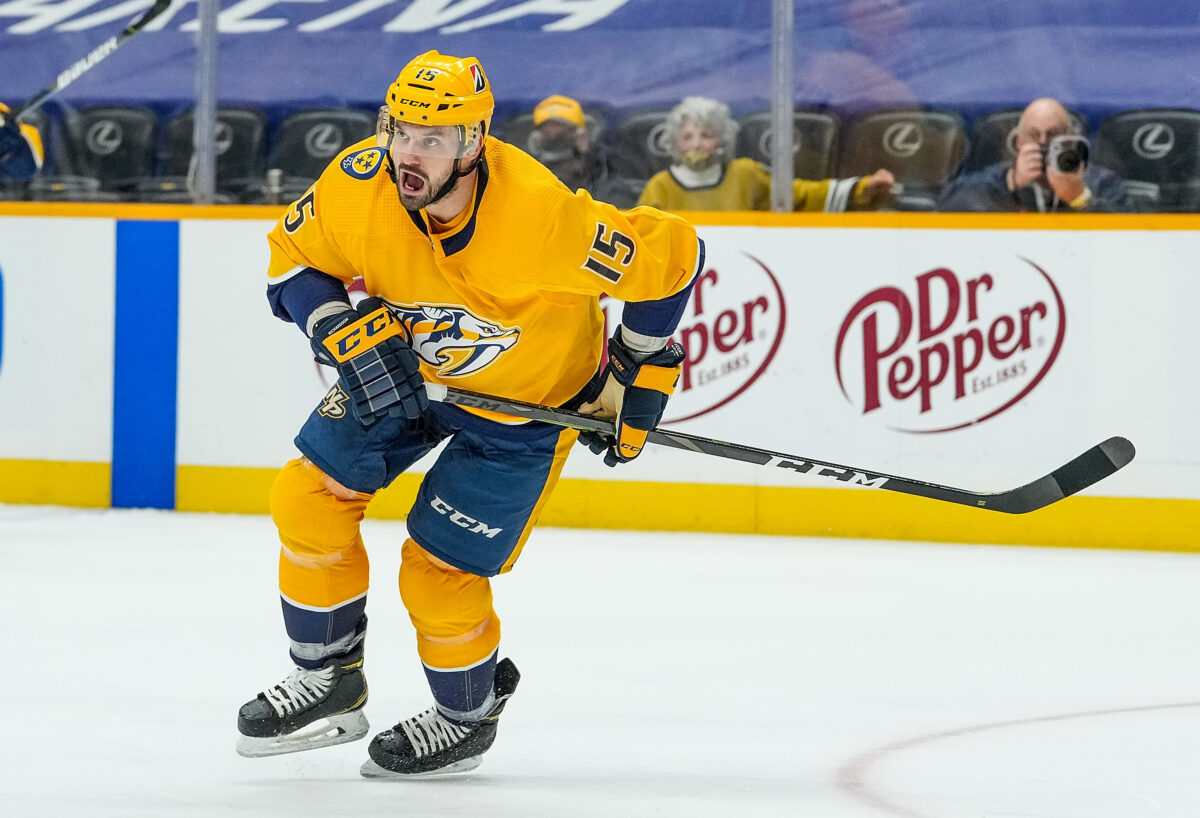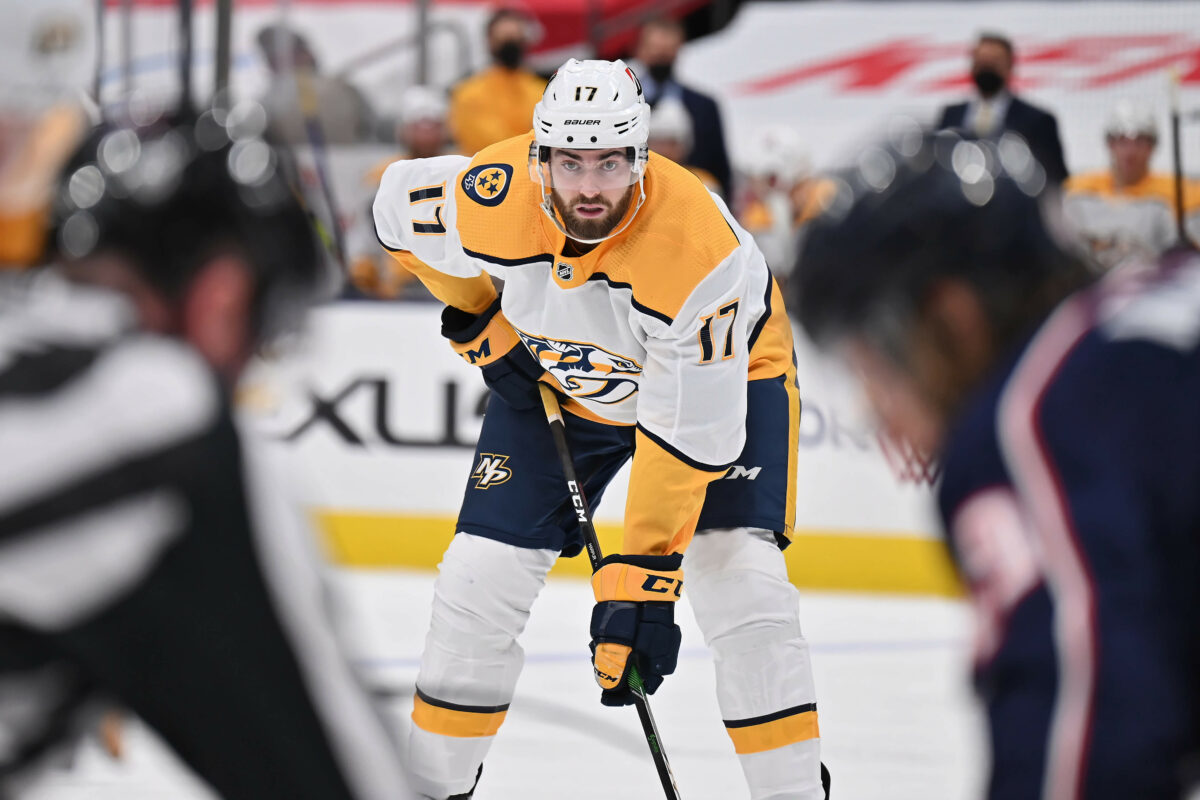We’re getting down to the nitty-gritty of report cards in this Nashville Predators report card series. I started with the players at the top of the lineup, and now I’m going over depth guys that may have had less (or more) of a contribution. Be ready to see some relatively low grades for some players that are coming up as we near the end.
Erik Haula
Erik Haula, like many other Predators players, was a tale of two halves. The first half of his regular season was awful. He was essentially nonexistent every time he touched the ice. The impact he was making was minimal at best, and fans were starting to get fed up with his mucking of passes and screwing up of scoring chances.
Then, something changed. With the run came a new Haula that fans had yet to see come to form this season. He looked far better on the penalty kill than he did earlier in the season and started to make positive contributions to the lineup. His numbers, however, are not great, as his goals above replacement (GAR) is 23rd out of 29 players, and his expected goals above replacement (xGAR) per Evolving-Hockey is dead last by a wide margin. Overall, his regular-season might have been better than the numbers suggest, but he still was not great, and it wasn’t exactly hard to spot.

As for the playoffs, Haula performed reasonably well in the points department, notching four of them in total, but again, his more advanced numbers weren’t living up to what was expected. His expected goals for percentage (xGF%) was an awful 33.66%–well below the average. The only player who had worse is someone who I’ll dive into later in this article. It wasn’t pretty. He didn’t generate a ton of offensive chances, and the defense was lackluster, to say the very least. The point totals are a bit deceiving here.
Overall, Haula was not great. I don’t think it would be wise of the Predators to bring him back, but I know some liked what they saw from him. For me, he was just another body filling up a roster spot for the majority of the year. I’d much prefer to see a player like Rem Pitlick than Haula, and many other Predators fans felt the same way after the clinic he put on in the short period that he was on the roster. I don’t think he lived up to the expectations that he brought with him in the regular season and playoffs, and I find it hard to justify bringing him back, even if outside of Mikael Granlund, I could most understand the team re-signing him.
Overall grade: C-
Brad Richardson
Pretty much a non-factor all year; Brad Richardson was an intriguing signing over the offseason. Having just previously ended the Predators’ season in the play-in round, he was brought in by general manager David Poile to do some fourth-line grind work and penalty killing. He ended up getting hurt and stayed out of the lineup for a while, totaling only 17 games played over the year. His numbers were mediocre, as he posted a minus-0.5 GAR and 1.1 xGAR. Unsurprisingly, he was a replacement-level player.

As for the playoffs, Richardson only played two games and logged a total of around 18 minutes of ice time within them. He didn’t play much, and the results within those minutes were below average. His xGF% was 40.54%, which isn’t great for such a short time. He was pretty much a non-factor, just as he was in the regular season.
Richardson’s season was unfortunately short, and he didn’t get a lot of opportunities. That being said, his numbers in the time he played were insufficient, and it would be a mistake to bring him back next season in the eyes of many.
Overall grade: D
Matt Benning
Matt Benning is probably the brightest spot of this particular report card article. He began the year with Mark Borowiecki on the third pair, but he was promoted to the top pair with Roman Josi with all of the injuries that happened. They were surprisingly excellent in their time together. At 5v5, their xGF% was the best on the team at 56.45%. They looked excellent, and Benning’s ability to support Josi’s offense through strong defense was evident throughout the season.
Benning’s metrics were interesting, mainly due to his GAR being low on the scale at 26th but his xGAR being eighth. Don’t let the GAR fool you; Benning performed extraordinarily well when called upon this season. The xGAR metric for a defenseman is the one that I rely on personally to build my judgements from, which is why I’m highly impressed with what Benning did.

The fall from grace hit hard, though, as Benning’s playoff performance was suboptimal. The one play that sticks out is the Martin Necas wrap-around goal from Game 5. Matt Duchene got beat on the rush, and while Necas was moving around the net, Benning just watched. When he realized what was happening, it was far too late, as he reached out with his stick and missed entirely.
His xGF% for the playoffs overall was the worst on the Predators at 33.5%. Being put with the next player I’m going to go over doesn’t help, as he seemed to be the regular burden on the third pair, but it’s still no excuse to be that low in these particular percentage numbers.
Benning had an outstanding regular season. When he was given optimal minutes with an excellent partner in Josi, Benning proved to be a very worthy defenseman. He was terrific, especially defensively. However, when he was put back on the third pair with limited minutes and a not-so-great partner, his numbers sorely lacked. It has to be sorted out, but it’s hard to fault him for his assignments.
Overall grade: C+
Ben Harpur
Ben Harpur was meant to be the seventh defenseman on the Predators roster. Without Borowiecki getting hurt, he would not have seen any ice time. However, the injury thrust him into a consistent spot on the third pair. His play there was not good. Sometimes fans could see him making good plays, but most of the time, his efforts were futile. He had loads of trouble defending the rush and would often get sidestepped by opposing forwards trying to dump the puck into the zone or bring it in with possession. His ability to transition the puck was nowhere to be found for the most part, so really, he was only there for the physical presence. His GAR was 1.2, and his xGAR was minus-2.5, which is the third-worst on the team for the season. He was, as most Predators fans expected, replacement level.

As for the playoffs, Harpur wasn’t good either. He posted the fourth-worst xGF% out of all players at 36.39%. His efforts with and without the puck didn’t do much good for the team. He was merely the body on the third pair, just as he was in the regular season. It just wasn’t clicking.
Benning and others had a hard time getting their games in check because Harpur wasn’t good enough. His numbers are not ideal for a third pair that has historically struggled and was a point of emphasis for Poile over the 2020 offseason. Again, it should be a priority to find some competent third pairing players, even if it comes in the form of a young gun like David Farrance, to pair with Benning. Harpur was not good enough.
Overall grade: D-
All of these players had eventful years in some way, shape, or form. Whether that be through getting promoted due to injury or being the one that was hurt, these depth players were forced into situations that weren’t entirely ideal. It’s by no fault of their own, and fans could hand out the benefit of the doubt. However, it needs to be given out sparingly as the conclusion shouldn’t end up with re-signing them.